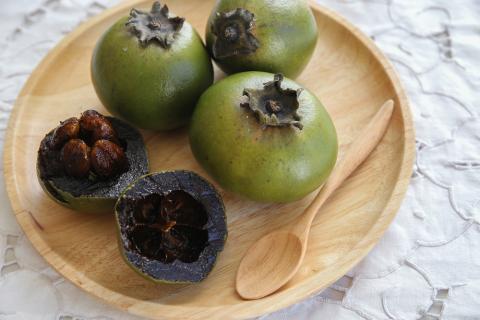
Sapoti is a member of the family Sapotaceae or Sapodilla family of the genus Sapota Mill., also known as sapota P, containing the species Sapota zapotilla (Jacq.) Cov. or manilkara zapota P. The plant is also called pouteria sapota, mamey sapote, marmalade tree, red mamey, and zapote. Sapoti is native to some islands in the Caribbean, Mexico, and Central America. The sap from the tree trunk is known as chicle and was used by the Aztec people to make chewing; it later became a main factor in the formation of the chewing gum industry.
The white sapoti tree does well where ever citrus can be grown but does not like arid climate or moist heat and does not tolerate windy conditions—but it will grow in temperatures as low as sixty-eight degrees.
Sapoti is a large coniferous tree that matures to approximately seventy-five feet in height with hard red-hued wood. It grows white flowers that produce fruit that grows to two-to-four inches in diameter and is spherical in shape with a rusty brown peel. The flesh of the sapoti fruit is a reddish-orange that has a mild, musky, sweet flavor with a creamy consistency. There is one large seed in each fruit that is shiny with a brown hue. The fruit is rich in nutrients and is an excellent food to help keep the body healthy. The fruit can be purchased at specialty stores and farm stands.
Health Benefits Of Sapoti
Sapoti is rich in nutrients and contains vitamins, A, B1 (thiamin), B2 (riboflavin), B5 (pantothenic acid), B6 (pyridoxine), and B9 (folic acid) in the form of folates, and C. The fruit is also a good source of minerals that include calcium, copper, phosphorous, magnesium, iron, and zinc. Other beneficial substances present in sapoti are proteins and dietary fiber.
Sapoti inhibits the development of many diseases. The fruit also contains tannins that have anti-viral and antibacterial properties that aid in the prevention of many gastrointestinal diseases. The vitamin C present in the fruit builds the immune system by reducing the free radicals that develop naturally in the metabolic function of the body, thus preventing infection. This vitamin also helps to keep the skin pliable and soft, preventing the formation of wrinkles.
Other health benefits of sapoti include the prevention of lower bowel diseases like irritable bowel syndrome (IBS) and constipation. It is an excellent fruit for pregnant and lactating women due to the presence of vitamin A which reduces the effects of morning sickness and increases the production of collagen, relieving the development of abdominal distress.
The mineral content of the fruit controls many areas of the body. Magnesium relaxes the blood vessels and potassium regulates blood pressure and thus they reduce the risk of developing cardiovascular diseases, The iron in sapoti helps to produce red blood cells and diminishes the development of anemia.
How To Grow Sapoti Trees
Sapoti trees can be grown in the garden in tropical and sub-tropical climate zones and do well in containers in colder climates. To germinate the seed, make a crack in the outer hull then place the seed in a one-gallon container filled one-half inch below the rim; cover the seed with twice its diameter with the potting soil, pack the soil, and water thoroughly. Place the container in a location that receives partial sunlight and keep it moist. The seeds will germinate within forty to seventy days after planting. As the roots grow transplant into larger containers. In March, July, and September fertilize the seedling with a fruit tree formula. If left as a container plant, restrict the container to an appropriate size and prune the tree as needed. To transplant outdoors find a warm and sunny location where the soil drains well and once planted keep the seedling well-watered for a few weeks if the weather is dry. The tree will flower in about seven years.
How To Eat Sapoti
There are many uses for sapoti that include eating the fruit fresh or using it as an ingredient in fruit salads. It can be juiced and blended into milk drinks. It can be added to yogurt and as an ingredient in smoothies. They can be included in jam and jelly recipes. Other variations of recipes for sapoti include ice creams and syrups.








